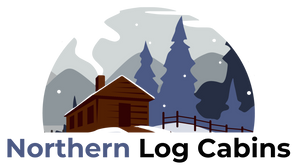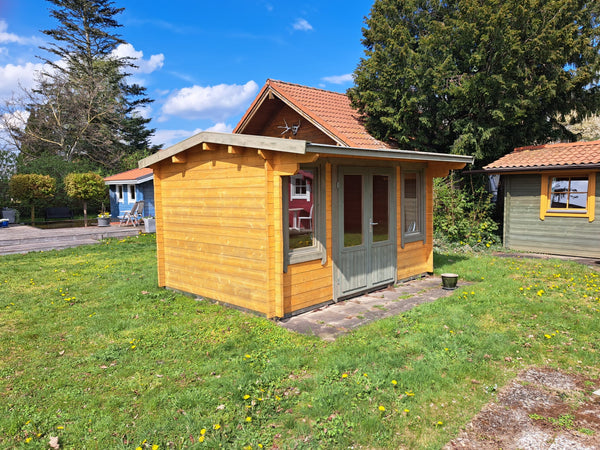Exploring the Definition and Characteristics of Log Cabins
Apr 26, 2024
When it comes to understanding log cabins, think of them as the sturdy, weathered storytellers of the forest, each bearing the marks of time and tradition. From their humble beginnings in the wilderness to their modern-day allure, log cabins have captivated the imagination with their rustic charm and timeless appeal.
But what exactly makes a log cabin unique, and what characteristics set it apart from other forms of housing? Join us as we unravel the intricacies of log cabins, from their historical significance to the practical challenges of building and maintaining these iconic structures.
Origins of Log Cabins
The origins of log cabins date back to the early days of North American settlement. European colonists first began to build these sturdy structures using the natural resources around them. These cabins were a practical choice for the early settlers, as they were readily available and provided much-needed shelter in the wilderness.
The process of constructing a log cabin was labor-intensive but straightforward. It involved felling trees and stacking the logs on top of one another, with the gaps filled using a combination of mud, clay, or moss to insulate against the elements. The design of log cabins was influenced by the traditions of the colonists' homelands, such as Scandinavia and Eastern Europe, where similar structures were common.
As the settlers moved westward, the log cabin became synonymous with the frontier lifestyle, embodying the spirit of self-sufficiency and resilience. Over time, the log cabin evolved from a basic shelter into a symbol of American ingenuity and resourcefulness, leaving a lasting legacy on the country's architectural landscape.
Traditional Construction Methods
As you explore the origins of log cabins, discovering the traditional construction methods becomes essential to understanding how these iconic structures were built. The following methods were commonly used:
- Log Selection: The first step in constructing a log cabin was carefully selecting suitable logs. These logs were typically sourced from nearby forests and had to be straight, sturdy, and of the right length for the intended structure.
- Notching Techniques: Once the logs were selected, the next step involved notching the ends of the logs to interlock them at the corners. Various notching techniques such as saddle notches, dovetail notches, and square notches were employed to ensure a secure and stable interlocking of the logs.
- Chinking and Daubing: After the logs were stacked and interlocked, the gaps between the logs were filled with a mixture of mud, clay, sand, and sometimes small stones. This process, known as chinking and daubing, helped to insulate the cabin and keep out drafts.
These traditional construction methods showcase the meticulous craftsmanship and resourcefulness of the builders, contributing to the enduring appeal of log cabins.
Types of Log Cabin Notches
Craftsmen employed various notching techniques to interlock the logs at the corners of log cabins, ensuring stability and durability. The saddle notch, also known as the saddle cope, is a widely used method. This notch involves cutting a semi-circular area on the bottom of the log so that it fits snugly onto the log beneath it.
Another common type is the dovetail notch, which resembles the tail of a dove. It's known for its interlocking design that provides exceptional resistance to settling and shifting.
The square notch, a simpler and quicker construction method, involves cutting a square notch at the end of each log to stack them on top of one another.
Finally, the Scandinavian full-notch technique features logs with a long groove on the bottom and a protruding tongue on the top, allowing for a tight fit.
Each type of notch contributes to the overall strength and stability of the log cabin, and the choice of notching technique often depends on factors such as tradition, available tools, and regional preferences.
Characteristics of Log Cabin Logs
To understand the characteristics of log cabin logs, consider their size, shape, and condition, as these factors significantly impact the construction and durability of the cabin.
- Handcrafted Logs: Handcrafted logs are often used in traditional log cabin construction, providing a rustic and authentic appearance to the structure.
- Log Thickness: The thickness of the logs determines the insulation and stability of the cabin, with thicker logs being more substantial and providing better insulation.
- Interlocking Structure: Log cabins are often built with interlocking corners, such as the Scandinavian full-scribe method, which enhances the structural integrity of the building.
The handcrafted logs used in log cabin construction contribute to the unique characteristics of these structures. The size and shape of the logs, along with their interlocking structure, define the exterior and interior aesthetics of the cabin. Additionally, the log thickness influences the cabin's ability to maintain a comfortable temperature and withstand environmental elements. Understanding these characteristics is crucial when considering the construction and durability of a log cabin.
Insulation and Energy Efficiency
Log cabin insulation and energy efficiency play a critical role in maintaining a comfortable and sustainable living environment. When it comes to insulation and energy efficiency, log cabins tend to have natural advantages due to the properties of the wood. The thickness and density of the logs provide inherent insulation, helping to regulate indoor temperatures by keeping the heat in during winter and the heat out during summer. Additionally, the thermal mass of the logs absorbs and stores heat, releasing it slowly to maintain a more consistent indoor climate. Properly sealed and insulated gaps between the logs further enhance the energy efficiency of log cabins by preventing air leakage.
To improve energy efficiency, consider adding insulation between the logs and in the roof and floor spaces. Modern techniques and materials, such as foam insulation or insulated panels, can be integrated without compromising the rustic charm of the log cabin. Upgrading windows and doors to energy-efficient models also contributes significantly to reducing heat loss. By addressing insulation and energy efficiency in your log cabin, you can create a more environmentally friendly and cost-effective living space while preserving its timeless appeal.

Roof Styles for Log Cabins
Enhancing the energy efficiency of your log cabin through proper insulation can also influence the choice of roof styles for your living space. When considering roof styles for your log cabin, it's important to take into account the type of roof that complements the overall design and structure of your distinctive log cabin.
Some popular roof styles for log cabins include:
- Gable Roof: This type of roof is characterised by its triangular shape and is commonly found in Nordic and historic log cabins. It provides a classic and traditional look to the cabin.
- Shed Roof: Often seen in rustic and bespoke log cabins, the shed roof is a single, sloping roof surface that covers the entire structure. It suits modern log cabins with a contemporary and unique design.
- Hip Roof: This style is characterised by all its sides sloping downwards towards the walls, usually with a fairly gentle slope. It's a popular choice for traditional log cabins, offering a timeless and elegant appearance.
When constructing your log cabin, the roof style should harmonise with the corners by notching or ends with notches, and the use of horizontal logs, milled logs, or tongue and groove in the structure built. Whether you aim for a traditional, unique, modern, or rustic look, the right roof style is pivotal in completing the overall aesthetic of your log cabin.

Distinctive Features of Log Cabin Interiors
When designing your log cabin interior, consider incorporating natural elements such as wood, stone, and leather to create a warm and inviting atmosphere. The interior of a log cabin should reflect the rustic charm of its exterior. Opt for exposed wooden beams to add a sense of authenticity and charm to the space.
Consider using reclaimed wood for flooring, walls, and ceilings to enhance the natural ambiance of the cabin. Stone fireplace surrounds and accents can add a touch of rugged elegance to the interior. Choose earthy and warm color palettes to complement the natural surroundings and bring a cozy feel to the space.
When selecting furniture, opt for comfortable leather sofas and chairs, adding to the natural and inviting atmosphere. Handcrafted wooden furniture pieces can further enhance the log cabin aesthetic. Additionally, incorporating elements of nature such as planters with greenery or floral arrangements can bring a sense of the outdoors inside, completing the cozy and welcoming ambiance of your log cabin interior.
Modern Amenities in Log Cabins
Consider incorporating modern amenities such as high-speed internet, smart home technology, and energy-efficient appliances to enhance the comfort and convenience of your log cabin living experience. When looking at log cabins for sale, it's important to envision the modern amenities that can complement the traditional charm of a log cabin. Here are a few modern amenities that can elevate your log cabin living:
- High-Speed Internet: Enjoy the tranquility of nature without sacrificing connectivity. With high-speed internet, you can stay connected to work, stream your favorite shows, or simply stay in touch with loved ones.
- Smart Home Technology: Integrate smart home features into your log cabin for added convenience and security. Control lighting, temperature, and security systems with ease, even when you're away.
- Energy-Efficient Appliances: Upgrade to energy-efficient appliances to reduce environmental impact and lower utility costs. Modern energy-efficient refrigerators, stoves, and HVAC systems can seamlessly blend into the rustic aesthetic of a log cabin while offering modern functionality.
Maintenance and Care for Log Cabins
To ensure the longevity and pristine condition of your log cabin, regular maintenance and diligent care are essential. Proper maintenance of your log cabin is crucial to protect it from the elements and preserve its natural beauty. Start by inspecting the exterior for any signs of damage such as cracks, gaps, or rot. Address these issues promptly to prevent further deterioration.
Regularly clean the exterior to remove dirt, mold, and mildew, and apply a fresh coat of protective finish every few years to safeguard the wood from moisture and UV rays.
Additionally, it's important to inspect and maintain the cabin's roof, ensuring there are no leaks or damaged shingles. Keep the surrounding area clear of debris and vegetation to prevent moisture buildup and pest infestation. Inside the cabin, monitor for any signs of pests or wood decay, and promptly address any issues to prevent further damage.
Regularly check the chinking and caulking between logs and reapply when necessary to maintain a tight seal and optimal insulation.
Choosing the Right Location
Select a location that offers ample sunlight and good drainage for your log cabin. When choosing your log cabin's location, consider the following factors to ensure a suitable setting:
- Sunlight: Look for a spot that receives plenty of sunlight throughout the day. Adequate sunlight not only helps to keep your log cabin warm and dry, but it also discourages mold and mildew growth.
- Drainage: Ensure that the location has good natural drainage to prevent water from pooling around the cabin. Poor drainage can lead to moisture buildup, which can compromise the structural integrity of the logs and create a damp living environment.
- Accessibility: Consider the accessibility of the location in terms of both construction and everyday use. A location that's easily accessible will make it simpler to transport building materials and will also be more convenient for you and your guests.
Permits and Regulations for Log Cabins
Understanding the local building permits and regulations is essential before beginning the construction of your log cabin. When it comes to log cabin construction, obtaining the necessary permits and adhering to building codes are crucial steps in the process. Before starting any work, it's important to check with your local government or building department to determine the specific requirements for your area.
Permits and regulations for log cabins typically cover a range of aspects, including zoning, environmental impact, structural integrity, and safety. Zoning regulations may dictate where on your property you can build a log cabin, as well as the size and height limitations. Environmental impact assessments may be required to ensure that the construction of your log cabin won't harm the surrounding ecosystem. Structural integrity and safety regulations are put in place to guarantee that the log cabin is built to withstand environmental factors and provide a safe living environment.
Customisation Options for Log Cabins
Before you start planning the customisation of your log cabin, it's essential to consider how these options will align with the permits and regulations you've already checked for your construction project.
When customising your log cabin, you have a range of options to personalise and enhance its functionality and aesthetics. Some popular customisation options for log cabins include:
- Interior Layout: You can customise the interior layout to suit your specific needs and preferences. This could involve creating open-plan living spaces, adding extra rooms, or incorporating unique features such as a loft area or a cozy fireplace.
- Exterior Finishes: Customising the exterior finishes of your log cabin allows you to choose the look and feel of the exterior walls, roof, and decking. Options range from traditional wood finishes to modern alternatives like metal or composite materials.
- Additional Features: Enhance your log cabin with additional features such as a porch, deck, or outdoor living space. These additions can extend your living area and provide opportunities for enjoying the natural surroundings.
When considering customisation options for your log cabin, it's important to prioritise features that align with your vision while also complying with relevant building codes and regulations.
Log Cabin Furniture and Decor
When furnishing your log cabin, consider incorporating rustic furniture and decor to complement the natural aesthetic of the surroundings. The charm of log cabins lies in their cosy and natural feel, and your furniture and decor can enhance this ambiance. Opt for sturdy, handcrafted wooden furniture that accentuates the raw beauty of the log building. Pieces made from hickory, cedar, or pine are popular choices for their durability and earthy appeal.
Look for items with simple, unadorned designs that showcase the wood's natural grain and texture. To add warmth and character to your space, consider incorporating soft furnishings like woolen blankets, plaid throws, and animal hide rugs. These elements bring a touch of rustic luxury to your log cabin while maintaining a connection to the natural environment.
For decor, embrace nature-inspired accents such as antler chandeliers, bark-trimmed mirrors, and wildlife-themed artwork. By integrating these elements, you can create a harmonious and inviting atmosphere that reflects the beauty of your log cabin retreat.

Advantages of Log Cabin Living
Living in a log cabin offers a unique sense of tranquility and connection to nature that's unparalleled in modern urban settings. The advantages of log cabin living include:
- Immersive Natural Surroundings: Waking up to the sight of towering trees, the sound of chirping birds, and the fresh scent of pine in the air provides a daily dose of natural therapy.
- Sustainable Living: Log cabins are often constructed from renewable resources, promoting a sustainable lifestyle that aligns with eco-friendly values.
- Peaceful Solitude: The seclusion offered by log cabin living allows for a peaceful retreat from the hustle and bustle of city life, providing a serene environment for relaxation and introspection.
Living in a log cabin grants you the opportunity to revel in the beauty of the great outdoors, fostering a deep appreciation for the environment and a slower, more mindful way of life. Embracing the advantages of log cabin living allows you to create a lifestyle that's in harmony with nature, promoting a sense of well-being and connection to the earth.
Log Cabins as Vacation Homes
Embracing the advantages of log cabin living, log cabins also serve as ideal vacation homes for those seeking a peaceful retreat in natural surroundings. The rustic charm of a log cabin creates a cozy and inviting atmosphere, making it a perfect getaway from the hustle and bustle of everyday life.
Whether nestled in the mountains, by a serene lake, or in a secluded forest, log cabins offer a unique vacation experience. The natural beauty that surrounds log cabin vacation homes provides a tranquil setting for relaxation and rejuvenation. Imagine waking up to the sound of birds chirping and the scent of pine trees in the crisp mountain air.
Log cabins offer a chance to disconnect from the chaos of urban living and reconnect with nature. Many vacation log cabins are equipped with modern amenities, ensuring a comfortable stay while still being immersed in the tranquility of the great outdoors. From romantic retreats to family vacations, log cabins cater to a variety of vacation preferences, making them an appealing choice for those seeking a peaceful and idyllic holiday experience.
Sustainability of Log Cabin Construction
The historical significance and enduring legacy of log cabins make their sustainable construction a topic of contemporary interest and importance.
When considering the sustainability of log cabin construction, it's essential to recognize that these structures are inherently eco-friendly. The use of logs as the primary building material aligns with sustainable practices, as it involves minimal processing and the reliance on a renewable resource. Furthermore, the thermal mass of the logs provides natural insulation, reducing the need for excessive heating or cooling systems. This characteristic not only contributes to energy efficiency but also aligns with modern sustainability standards.
Additionally, the longevity of log cabins exemplifies sustainability, as they often outlast other types of construction, reducing the environmental impact associated with frequent renovations or replacements.
While traditional log cabins embody sustainable construction practices, modern advancements in log cabin design and construction techniques further enhance their sustainability, ensuring that these iconic structures continue to be relevant in contemporary times. Incorporating sustainable practices into log cabin construction preserves their historical charm while making them environmentally responsible choices for modern living.
Challenges of Building a Log Cabin
Building a log cabin presents unique challenges due to the precise fitting and joining of the logs to create a structurally sound and weather-resistant home. When building a log cabin, you'll encounter several challenges that require careful consideration and expertise:
- Log Selection and Preparation: Choosing suitable logs that are properly seasoned and free from rot or insect damage is crucial. Preparing the logs by peeling, drying, and treating them to prevent future issues is a time-consuming task.
- Joinery and Settlement: Achieving tight-fitting joints and ensuring the logs settle evenly over time to prevent gaps or structural issues can be quite challenging. Proper techniques and close attention to detail are essential to address these concerns.
- Maintenance and Longevity: Building a log cabin requires ongoing maintenance to protect against weathering, insect infestations, and decay. Understanding the specific maintenance needs of a log cabin and implementing a proactive maintenance plan is vital for its longevity.
These challenges highlight the intricate nature of building a log cabin and the importance of careful planning, skilled craftsmanship, and ongoing maintenance to ensure a durable and enduring structure.
Resale Value of Log Cabins
Amidst the challenges of building a log cabin, it's essential to consider the potential resale value as a key aspect of your investment in this unique property. Log cabins often hold a strong appeal for buyers due to their rustic charm and connection to nature. This can positively impact their resale value and make them an attractive investment.
The resale value of log cabins is influenced by various factors such as location, craftsmanship, and the quality of materials used. Log cabins situated in picturesque natural settings or near popular tourist destinations tend to have higher resale values. Additionally, the craftsmanship and quality of construction play a significant role. Well-maintained log cabins with high-quality materials and attention to detail often command higher prices in the real estate market.
It's important to note that the resale value of log cabins can be influenced by market trends and demand for rustic properties. Therefore, staying informed about real estate trends and making thoughtful investments in your log cabin can positively impact its resale value.
Conclusion
Now that you've learned about the origins, construction, and characteristics of log cabins, you can appreciate their charm and enduring appeal.
Like a cosy embrace from an old friend, log cabins offer warmth, comfort, and a connection to nature.
Whether you're considering building one yourself or simply admiring their historic significance, log cabins continue to capture the imagination and hearts of people around the world.







